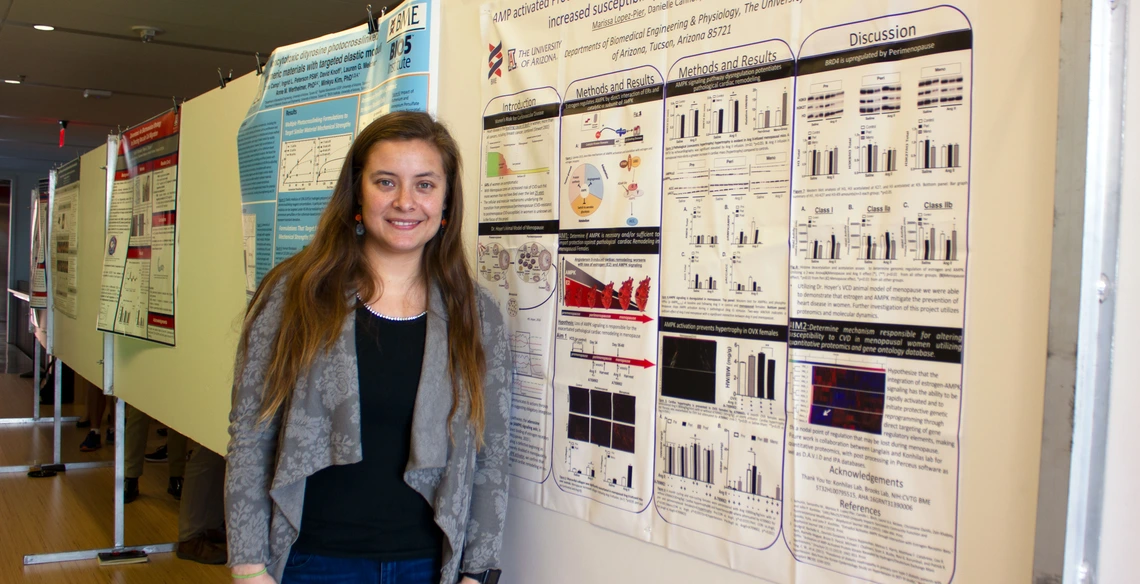BME Students Share Work at Research Expo
Students present research on disease detection, heart health and devices to improve surgical processes at the 8th Annual Biomedical Engineering Research Expo.

Marissa Lopez-Pier, a fifth-year PhD student working with associate professor John Konhilas, shared her research about how the onset of menopause affects women's risk of heart disease.
Nearly 50 biomedical engineering students, as well as several students and researchers in related fields, presented their work on early cancer detection methods, heart disease and medical imaging at the University of Arizona’s 8th Annual Biomedical Engineering Research Expo.
The event was sponsored by longtime department supporter W.L. Gore, and Léna Borbouse, product specialist in thoracic aortic devices from the company, was the keynote speaker. Bruce J. Tromberg, director of the National Institute of Biomedical Imaging and Bioengineering within the National Institutes of Health, gave a speech about his work in the field of biophotonics imaging and disease detection.
“You can extract lots of information from tissues,” he said. “We begin to think, ‘Can we get all this information and use it to prevent disease?’”
Monitoring Optic Nerve Health
“Living systems are so incredible. You can never replicate how amazing they are, but the thing with biomedical engineering is you can try,” said Bridget Slomka, a BME senior who works with associate professor Marek Romanowski. “I’m not just designing supports for a bridge or making a handheld device more ergonomic. I’m addressing problems with the body and, ideally, solving them in ways that can dramatically improve lives.”
Slomka won third place in the undergraduate category with her poster about a tiny camera attached to a contact lens to monitor the health of the optic nerve during brain surgery. The current method for making sure the optic nerve hasn’t been damaged during surgery involves a surgeon’s assistant shining a light into the patient’s eye to ensure it properly dilates. This disruption must be performed periodically throughout the surgery.
“’This device just completely automates that process,” Slomka said. “It’s consistently going and taking measurements, so you’ll know right away if there’s damage.”
Battling Disease in Women
Senior Steven Santaniello, an optical sciences and engineering major who works with BME Professor and BIO5 Director Jennifer Barton, received the “Most Promising Research” award for his ovarian cancer detection research.
“Despite being rare, ovarian cancer is still one of the top five oncological causes of death for women,” he said. “We are using two strains of mice to evaluate different imaging techniques to see how well they can detect cancer. The goal of it all is to find which method would best serve in an endoscope.”
Living systems are so incredible. You can never replicate how amazing they are, but the thing with biomedical engineering is you can try."
Marissa Lopez-Pier, a fifth-year PhD student who works with associate professor John Konhilas, also studies disease in women. She researches how the onset of menopause affects women’s risk of heart disease, with a current focus on the chemical AMPK, which regulates stress in the heart.
“Persistent stress leads to heart disease,” Lopez-Pier said. “Our hypothesis is that loss of estrogen is coupled with loss of AMPK function, which enlarges the heart.”
Studying Salmonella, Analyzing Arrythmia
BME sophomore Anakaren Romero-Lozano shared the work she’s doing with Professor Jeong-Yeol Yoon on a portable, easy-to-use, particle-based pathogen sensor. Traditional pathogen detection methods require specially trained technicians and, often, expensive laboratory equipment. The team is developing a device that can be used out in the field to detect E.coli, salmonella and staphylococcus.
“The next step is to use a smartphone microscope instead of a benchtop microscope, to make it more portable and easier to use,” Romero-Lozano said.
Jokubas Ausra, a PhD student working in the Gutruf Lab, received third place among graduate students for his presentation about a wireless pacemaker that helps scientists study heart failure in mice.
“It uses both light and electricity, so it’s multimodal, along with being completely wireless and battery-free,” Ausra said. “It can help us better understand how heart failure and heart arrhythmia work and what we can do to prevent it.”
Ausra added that he came to the University of Arizona because he was interested in studying the human-machine interface through biomedical engineering, and he has thoroughly enjoyed his experience in the department thus far.
“The lab culture is really nice, and I have a lot of good collaborators I work with around the U.S. and even outside the country,” he said. “My lab mates are all helpful. It’s a very ‘share your knowledge’ kind of environment.”
All Winners
Graduate students (judged by non-participating first-year graduate students)
First place: David Knoff
Second place: Loi Do
Third place: Jokubas Ausra
Undergraduate students (judged by W.L. Gore representatives)
First place: Andre Coella Hernandez, senior
Second place: Collin Preszler, first-year
Third place: Bridget Slomka, senior
Most creative research: Samantha Schatz, first-year
Most promising research: Steven Santaniello

